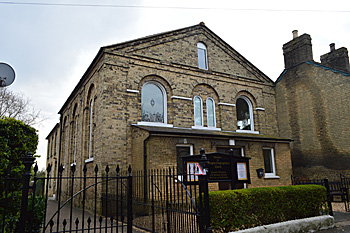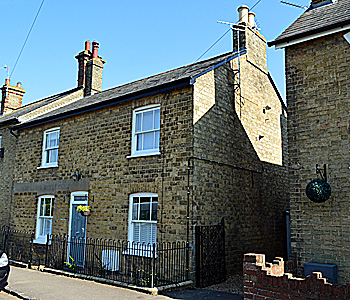Congregationalists in Shillington

Shillington Congregational Church April 2015
Congregationalists is the current term for that those Protestant nonconformists formerly known as Independents. The old term is very descriptive as each chapel maintained its independence, electing its own officials and choosing its own ministers. The Independents were frequently to be found worshipping with Baptists who had a similarly independent philosophy.
In his Shillington Congregational Church published in 1950 Herbert W Cooper laments: "It is deeply to be regretted that the account of the early formation of the Church at Shillington up to 1852 has been lost for all time through the shameful "mutilation" of the Early Church records by some person unknown". Records from Back Street Meeting House in Hitchin [Hertfordshire] however, show that a man named Geard introduced the cause to Shillington in 1798. Registrations of two buildings in Shillington were made in that year and these may perhaps be the first Congregationalist meetings.
Rev C Stoper from Hitchin made efforts between 1817 and his death in 1825 by which time he had built up a good sized congregation. A building was registered in 1822, again the denomination is unstated but could have been by Congregationalists. Flint held the land belonging to 91 Church Street and a barn in the yard of this property may have been used for worship. Herbert Cooper relates: "At this time a violent persecution was raised, which continued with but little intermission for several years and the minister and others were often in great danger from the attack of the persecutors. The persecution at length ceased and the seed which had been sown in troublous times sprang up and brought forth fruit to the glory of God".

91 Church Street March 2014
The foundation stone of the present [2015] Congregational chapel in Church Street was laid on 23rd August 1840 and the building was registered on 19th November 1841 by Charles James Metcalf junior and Thomas Newling, two of the trustees [ABN1/2; ABN2/247; ABN3/3]. The chapel was registered for marriages on 25th October 1860. In 1841 the Bunyan Meeting presented a twelve old chandeliers to the chapel [BY9/2].
On Sunday 30th March 1851 a census of all churches, chapels and preaching-houses of every denomination was undertaken in England and Wales. The local results were published by Bedfordshire Historical Records Society in 1975 as Volume 54, edited by D. W. Bushby. The return for the Shillington stated that there wer 160 free sittings and130 other. General congregation 150 in the morning. 154 in the afternoon and 190 in the evening with 125 Sunday scholars in the morning and 130 in the afternoon. The minister, Henry Howard Morris helpfully gave the averages as 130 general congregation in the morning, 145 in the afternoon and 175 in the evening with 120 Sunday scholars in the morning and 125 in the afternoon. He wrote: "As three services are held on Sabbath Day the average number of hearers will be about 200 as many are present during part of the day who are not present the other part of the day. Number of scholars on the books 166".
Two side galleries were built in the chapel in 1859 and additional pews placed downstairs [X846/1/1]. A harmonium was purchased in 1863, replaced by an organ three years later, this organ, itself, being replaced in 1886. In1895 a Sunday school building was added to the rear of the chapel [X846/1/2].
In 1897 the Manse at 13 Church Street was bought [X846/1/2]. The Rating and Valuation Act 1925 specified that every building and piece of land in the country was to be assessed to determine its rateable value. The valuer visiting the Manse [DV1/C74/124] found it comprised two living rooms, a kitchen, a scullery and four bedrooms as well as two barns with a loft over. In 1934 electric light was installed in the chapel [X846/1/3]. Around this time, so Herbert Cooper recalls, attendance was at a low ebb but was gradually built up by lay pastor E P Rand and the church was renovated in 1939 [X846/1/3].
Bedfordshire and Luton Archive and Record Service has the following material relating to the Congregational church in Shillington:
- X846/1/1: minute book: 1852-1876;
- X846/1/2: minute book: 1876-1907;
- X846/1/3: minute book: 1907-1943;
- X846/2/1: Sunday school minute book: 1922-1944;
- X846/1/4: minute book: 1944-1979;
- X674/6: marriage register: 1947-1992;
- X846/3/1: Congregational Guild minute book: 1954-1991;
- X846/1/5: minute book: 1980-1993.
In his book Herbert Cooper traced the ministers of the meeting, listing them as follows:
- 1825: C Stoper, Minister at Hitchin;
- 1825-1839: John Wayne, Minister at Hitchin;
- 1839-1840: James Paxton;
- 1840: - Compton;
- 1840-1842: G W Conder;
- 1842-1844: Fred Holmes;
- 1844: H H Morris;
- 1852-1857: I H Irwin;
- 1858-1861: J S Darley;
- 1862-1863: John Skinner;
- 1863: students from J Jukes' Academy in Bedford;
- 1863-1865: Collin Fairfax;
- 1865-1892: B Culpin;
- 1893: Charles W Sykes, student;
- 1893: J A Hopgood, student;
- 1894: Martin John French, student;
- 1894: D S Carlyle, student;
- 1894: J Calvin, student;
- 1896-1901: James W Smith;
- 1901-1902: John W Veevers;
- 1902-1903: John Evans;
- 1904-1919: M L Gooby;
- 1920-1923: Humphrey Williams;
- 1924-1929: F kenworthy;
- 1930-1934: James Sidebottom;
- 1935-1942: E P Rand, lay pastor;
- 1942 -: Herbert W Cooper.

13 Church Street - The Manse July 2015